As the news cycle perpetually churns out updates, it becomes imperative for video advertisers to optimize YouTube ads with trending negative keywords. Beyond employing negative keywords that universally apply to your ads or campaigns, it’s essential to continually update and refine your list based on recent news and headlines.
Discover how excluding trending negative keywords ensures that your ads only surface alongside content that aligns with your brand, giving you greater control over your YouTube advertising placements.
Improving Targeting by Excluding Trending Negative Keywords in YouTube Ads
What seems like an attractive keyword and suitable content today may quickly become unsuitable tomorrow. For instance, Russia was a popular tourist destination before the pandemic and before the 2022 Russian invasion of Ukraine. As a travel agent, targeting terms related to Russian tourism was beneficial then. However, with the current news about Russia, obtaining searches and leads for travels to Russia may be close to zero.
Optimizing YouTube ads with trending negative keywords is often overlooked in exclusion strategies. While establishing a negative keywords list sets a solid foundation, the dynamic nature of YouTube advertising demands a continuous effort to stay relevant. Therefore, integrating the practice of optimizing YouTube ads with trending negative keywords ensures your campaigns align with current user preferences.
What Are Trending Negative Keywords in YouTube Advertising
To understand the function of trending negative keywords, it’s essential first to grasp the fundamental concept of negative keywords. In simple terms:
“Negative keywords are specific words or phrases designated during campaign setup to ensure your ads don’t appear when these words or phrases are searched.”
When structuring your YouTube advertising campaign, you can include up to 5,000 negative keywords on your exclusion list. Particularly in expansive campaigns targeting a broad audience, it’s seldom practical to utilize the full 5,000. Here’s where the optimization of YouTube ads with trending negative keywords comes into play. This strategic approach involves keeping your list updated with emerging news and current events, making sure your ads steer clear of undesired placements.
This practice entails the routine addition of new keywords reflecting current events. For instance, if you’re a media buyer representing a banking company, it becomes prudent to distance your ads from searches related to interest rate rises and news on financial crises.
How To Identify Trending Negative Keywords For YouTube Ads
When it comes to pinpointing trending negative keywords for your YouTube video ads, there are two distinct methods you can utilize:
Identify the most relevant trending negative keywords for YouTube ads based on search queries
Predict upcoming trending negative keywords for YouTube ads with AI tools and analytics
Using these methods, how can you accomplish a trending negative keyword list in YouTube ads?
Let’s start with this example:
Brand: Real estate agent for luxury properties in Chicago.
Campaign: Back-to-school sale for a property near a school district.
A. Identify the most relevant trending negative keywords for YouTube ads based on search queries
1. For example, take one of your selected target keywords, “Top Chicago school districts” and enter it into Google News.
- Tip: Add the closest timeframe to your campaign launch to make it more timely and relevant. e.g. “Top Chicago school districts 2024”
2. As you search, examine the trending news related to your chosen topic. This could encompass both positive and negative trends.
To focus on the negative aspects, refine your search by adding the phrase “negative news”.

3. From the results, you can identify and add the following to your trending negative keywords list for YouTube ads:
- School shootings
- State of emergency
B. Predict upcoming trending negative keywords for YouTube ads with AI tools and analytics
Drawing insights from the web, Bard, Google’s AI tool, offers users accurate and high-quality responses when looking up trending negative keywords. Its integration with Google enhances efficiency, delivering comparable results in less time with the right prompts.
Going back to our example:
Brand: Real estate agent for luxury properties in Chicago.
Campaign: Back-to-school sale for a property near a school district.
To utilize Bard effectively, you can input a tailored prompt to obtain a trending list of negative keywords for your YouTube advertisements.

Advantages Of Implementing A Trending YouTube Ad Negative Keyword List
Incorporating a trending YouTube ad negative keyword list into your campaigns holds numerous advantages, particularly during heightened interest or hype periods. Let’s explore the key benefits:
Another Step Towards Brand Suitability
- By steering your ads clear of potentially controversial or negative trending topics, we proactively protect your brand image, preventing unwanted associations.
- Strike Social has outlined five essential steps in pursuing brand suitability:
- As Strike Social actively aims to optimize YouTube ads with trending negative keywords, our commitment is evident in ensuring that each YouTube campaign appears only with safe, suitable content aligned with its unique brand identity.
Refining Targeting In YouTube Advertising
- Trending topics can attract searches from users with no genuine interest in your product or service.
- Media buyers must strategically block specific trending negative keywords to prevent your ads from appearing on videos with irrelevant content.
Reduced Campaign Workload
- Utilizing a trending negative keyword list is a time-saving measure, sparing you the need for continuous monitoring and manual exclusion of irrelevant placements.
- Trending negative keywords may risk your campaigns for a certain period. By incorporating a trending negative keywords list in YouTube ads (at a campaign or account level), you establish a proactive defense by ensuring that subsequent campaigns or ads won’t inadvertently appear alongside the identified trending negative keywords.
Efficient management of your trending negative keywords list in YouTube ads is an ongoing process that requires continual upkeep and fine-tuning. Consider the following recommendations:
Stay Updated
Given the swift trends, you must consistently review and update your trending negative keyword list. Your list must remain pertinent, aligning with the changing dynamic of user search behavior.
Use Broad Match Modifiers
Use broad match modifiers to help capture variations and potential misspellings of your target terms, providing more comprehensive protection against unintended content associations.
Monitor Performance
Track your campaign metrics both with and without its application. Allow for timely adjustments for the continued efficacy of your trending YouTube ad negative keyword list.
How Trending Negative Keywords Contribute to Brand Suitability on YouTube
At its core, your main goal may be to attract views and conversions through your YouTube advertisements. However, it’s crucial to understand that viewers form perceptions based on the content linked to your video ads. This connection is what makes a lasting impression on them.
Maintaining the suitability of your ads for viewers is a continuous effort, mirroring the continuous change in the landscape of YouTube advertising. Adapting to these shifts is essential for media buyers. Incorporating a trending list of negative keywords into your YouTube ads is a significant step toward achieving overall brand suitability for your campaigns.
Expand your expertise. Browse Strike Social’s latest blogs here:
- How to Run Partnership Ads on Instagram: From Creator Collaboration to Paid Promotion

- Back-to-School Advertising Ideas to Secure Sales During Shopping Periods

- YouTube Ads Statistics: Global Trends & Data for Your 2025 Campaigns

- How to Combine YouTube and Google Search Ads for Better Results

- How Facebook Feed Ads Achieve Efficiency in Meta Placements

- Inside Strike Social’s Media Buyer Training 2025















